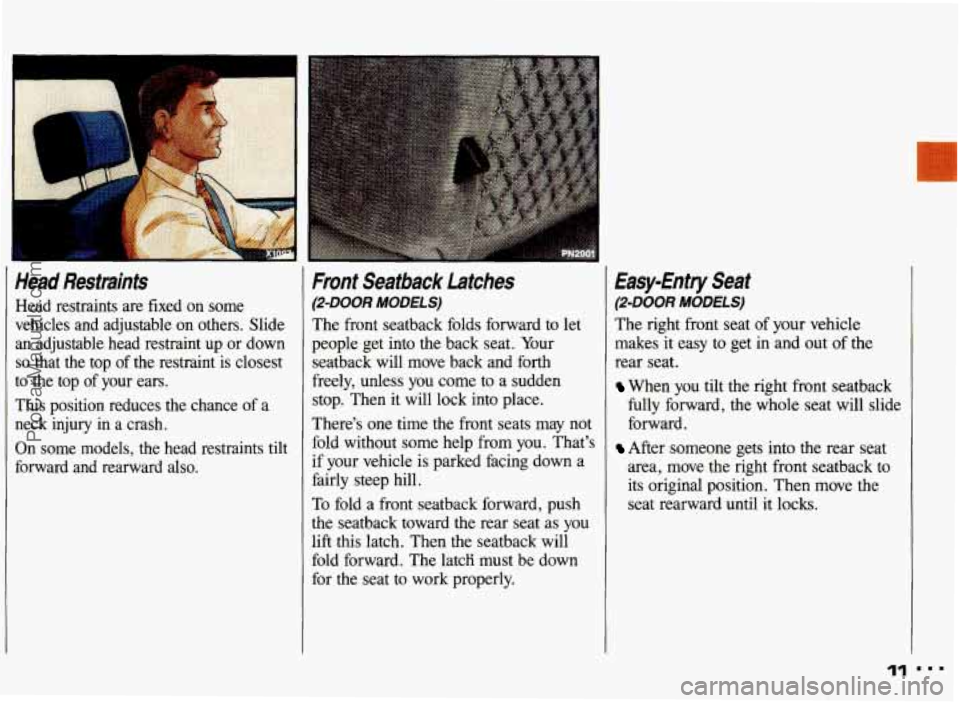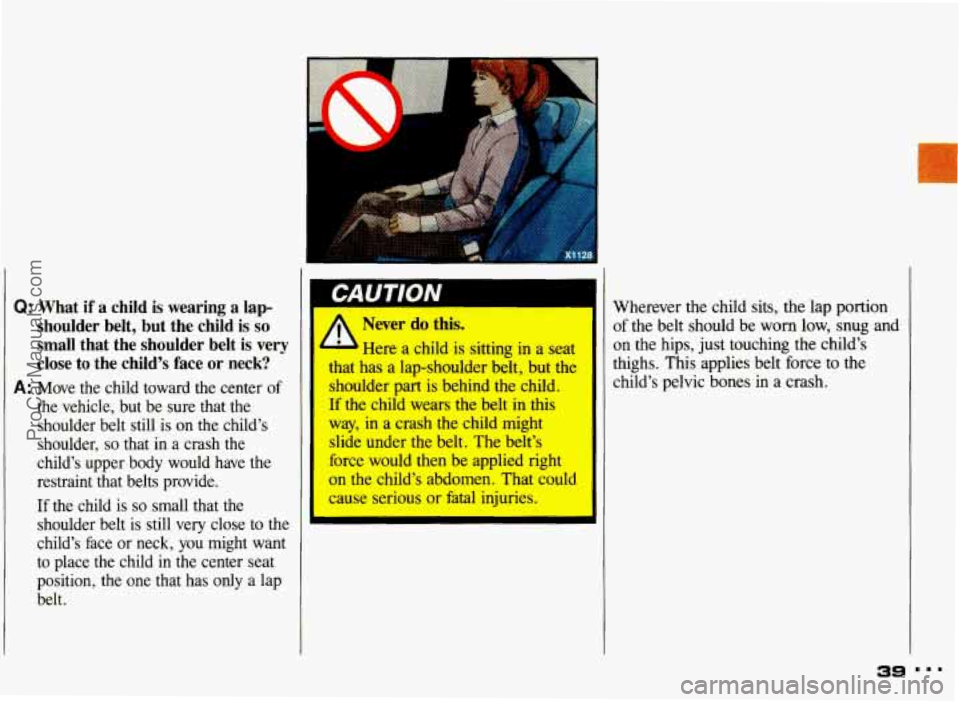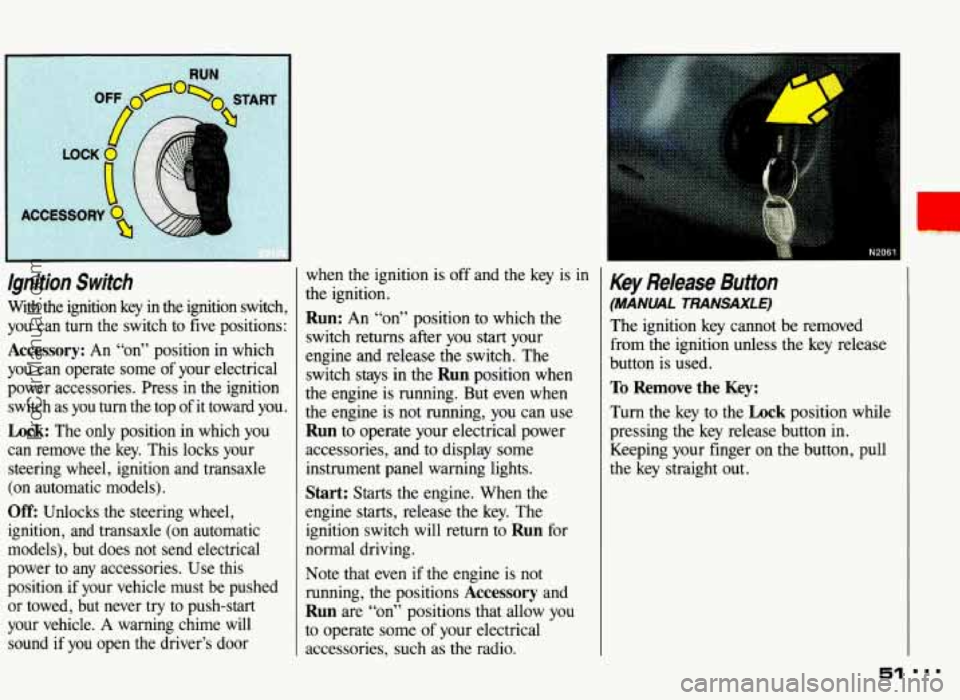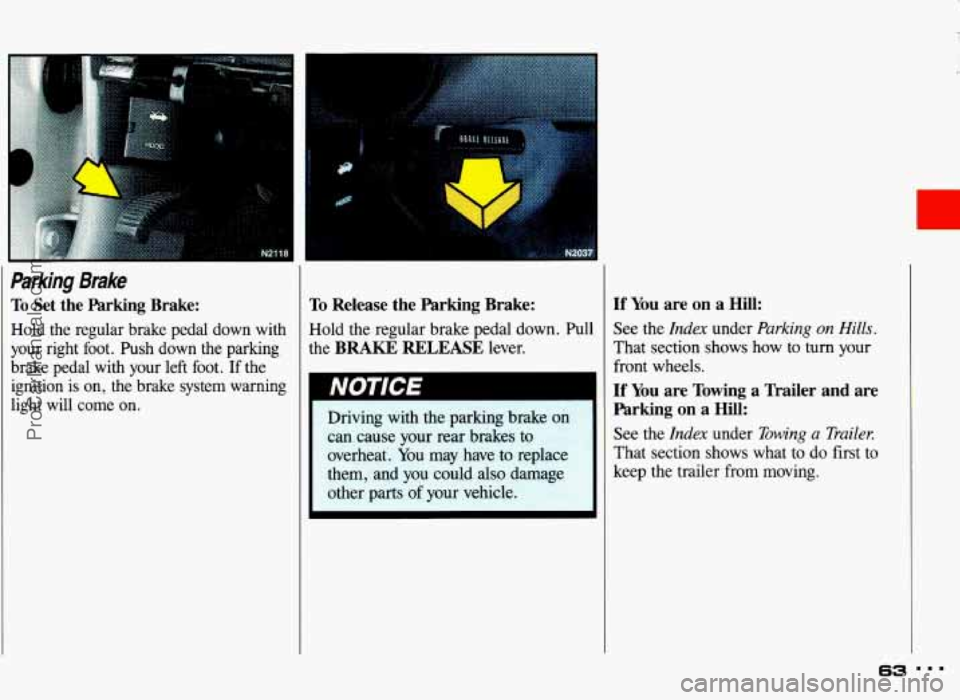1993 PONTIAC GRAND-AM tow
[x] Cancel search: towPage 12 of 306

Head Restraints
Head restraints are fixed on some
vehicles and adjustable on others. Slide
an adjustable head restraint up or down
so that the top of the restraint is closest
to the top of your ears.
This position reduces the chance of a
neck injury in a crash.
On some models, the head restraints tilt
forward and rearward
also.
Front Seatback Latches
(2-DOOR MODELS)
The front seatback folds forward to let
people get into the back seat. Your
seatback will move back and forth
freely, unless you come to a sudden
stop, Then it will lock into place.
There's one time the
front seats may not
fold without some help from you. That's
if your vehicle is parked facing down a
fairly steep hill.
To fold a front seatback forward, push
the seatback toward the rear seat as you
lift this latch. Then the seatback will
fold forward. The latcH must be down
for the seat to work properly.
Easy-Entry Seat
(2-DOOR MODELS)
The right front seat of your vehicle
makes it easy to get in and out of the
rear seat.
When you tilt the right front seatback
fully forward, the whole seat will slide
forward.
After someone gets into the rear seat
area, move the right front seatback to
its original position. Then move the
seat rearward until it
locks.
ProCarManuals.com
Page 40 of 306

Q: What if a child is wearing a lap-
shoulder belt, but the child is
so
small that the shoulder belt is very
close to the child’s face or neck?
A: Move the child toward the center of
the vehicle, but be sure that the
shoulder belt still is on the child’s
shoulder,
so that in a crash the
child’s upper body would have the
restraint that belts provide.
If the child is so small that the
shoulder belt is still very close
to the
child’s face or neck, you might want
to place the child in the center seat
position, the one that has
only a lap
belt.
I
Never do this.
A Here a child is sitting in a seat
that has a lap-shoulder belt, but the
shoulder part is behind the child.
If the child wears the belt in this
way, in a crash the child might
slide under the belt. The belt’s
force would then be applied right
on the child’s abdomen. That could
cause serious or fatal injuries.
‘I
Wherever the child sits, the lap portion
of the belt should be worn low, snug and
on the hips, just touching the child’s
thighs. This applies belt force
to the
child’s pelvic bones in a crash.
3s
ProCarManuals.com
Page 51 of 306

Features & Controls
Remote Trunk Release (CONK)
Lockout Feature:
The remote trunk release is equipped
with a lockout feature to help prevent
unauthorized entry into the trunk when
leaving the vehicle unattended. The
switch is located on the inside of the
trunk lid, mounted to the
trunk lid latch.
To turn the lockout on, slide the switch
all the way to the right.
To turn the
lockout off, slide the switch all the way
to the left.
When the lockout is on, the mechanical
remote trunk release will not release the
trunk lid. However, the trunk lid can
still be opened with the key.
Glove Box
Use the door key to lock and unlock the
glove box. To open, pull the glove box
handle toward you. Your
modern Pontiac doesn’t need
an elaborate “break-in.” But
it will
perform better in the long run if
you follow these guidelines:
Don’t drive at any one speed-
fast or slow-for the first 500
miles (804 km). Don’t make full-
throttle
starts
Avoid making hard st+ for the
first
200 miles (322 km) or so.
During this time your new brake
linings aren’t yet broken in. Hard stops with new linings can mean
premature wear and earlier
replacement. Follow this
“breaking-in” guideline every
time you get new brake linings
ProCarManuals.com
Page 52 of 306

lgnition Switch
With the ignition key in the ignition switch,
you can turn the switch
to five positions:
Accessory: An “~n” position in which
you can operate some of your electrical
power accessories. Press in the ignition
switch as you turn the top of it toward you.
Lock: The only position in which you
can remove the key. This locks your
steering wheel, ignition and transaxle
(on automatic models).
Off: Unlocks the steering wheel,
ignition, and transaxle (on automatic
models), but does not send electrical
power to any accessories. Use this
position if your vehicle must be pushed
or towed, but never try to push-start
your vehicle.
A warning chime will
sound if
you open the driver’s door when
the ignition is
off and the key is in
the ignition.
Run: An “on” position to which the
switch returns after you
start your
engine and release the switch. The
switch stays in the
Run position when
the engine is running. But even when
the engine is not running,
you can use
Run to operate your electrical power
accessories, and
to display some
instrument panel warning lights.
Start: Starts the engine. When the
engine starts, release the key. The
ignition switch will return to
Run for
normal driving.
Note that even if the engine is not
running, the positions
Accessory and
Run are “on” positions that allow you
to operate some of your electrical
accessories, such
as the radio.
Key Release Button
(MANML TRANSAXLE)
The ignition key cannot be removed
from the ignition unless the key release
button is used.
To Remove the Key:
Turn the key to the Lock position while
pressing the key release button in.
Keeping your finger on the button, pull
the key straight out.
51 ...
ProCarManuals.com
Page 55 of 306

Features & Controls
Both Transax/es (CONTI
Holding your key in Start for
longer than
15 seconds at a time
will cause your battery
to be
drained much sooner. And the
excessive heat can damage your
starter motor.
4. If your engine still won’t start (or
starts but then stops), it could be
flooded with too much gasoline.
Try
pushing your accelerator pedal all tht
way to the floor and holding it there
as you hold the key in
Start for abou
three seconds. This clears
the extra
gasoline from the engine. If the
vehicle
starts briefly but then stops
again, do the same thing, but this
time keep the pedal about one-
quarter of the way down for five or
six seconds. Your
engine is designed to work
with the electronics in
your
vehicle. If you add electrical parts
or accessories, you could change
the way the
fuel injection system
operates. Before adding electrical
equipment, check with your dealer.
If
you don’t, your engine might not
perform properly.
If you ever have to have your
vehicle towed, see the part of this
manual that tells how to
do it
without damaging your vehicle. See the
Index under Towing Your
Pontiac.
To Start Your 3300 V6 Engine
(Code N):
1. Don’t push the accelerator pedal
before starting your engine. In some
other vehicles you might need to
do
this, but because of your vehicle’s
computer systems, you don’t.
2. Turn your ignition key to Start.
When the engine starts, let go of the
key. The idle speed will go down as
your engine gets warm.
3. If it doesn’t start right away, push the accelerator pedal about one-quarter of the way down while you
turn the
key to
Start. Do this until the engine
starts.
As soon as it does, let go of
the key and the accelerator pedal.
m.. 54
ProCarManuals.com
Page 56 of 306

NOTICE
Holding your key in Start for
longer than
15 seconds at a time
will cause your battery to be
drained much sooner. And the excessive heat can damage your starter motor.
4. If your engine still won’t start (or
starts but then stops), it could be
flooded
with too much gasoline. Try
pushing your accelerator pedal all thl
way to the floor and holding
it there
as you hold the key
in Start for abou
15 seconds. This clears the extra
gasoline from the engine.
Turn the
ignition key to
Off. Wait 10 seconds:
then repeat step
3.
1lL
Your engine is designed to work
with the electronics in your
vehicle.
If you add electrical parts
or accessories, you could change
the way the fuel injection system
operates. Before adding electrical
equipment, check with your dealer.
If you don’t, your engine might not
perform properly.
If you ever have to have your
vehicle towed, see the part of this
manual that tells how to do it
without damaging your vehicle.
See the
Index under Towing bur
Pontiac.
Triving Through Deep Standing
Vater
NOTICE I
If you drive too quickly through
deep puddles or standing water,
water can come in through your
engine’s air intake and badly
damage your engine. If you can’t
avoid deep puddles or standing
water, drive through them very
slowly.
5E ...
ProCarManuals.com
Page 59 of 306

Features & Controls
Park (CONT.)
Ensure the shift lever is fully in P (Park)
range before starting the engine. Your
Pontiac has a brake-transaxle shift
interlock. You have
to apply your
regular brake
before you can shift from
P (Park) when the ignition key is in the
Run position. If you cannot shift out of
P (Park), ease pressure on the shift
lever-push the shift lever all the way
into
P (Park)-as you maintain brake
application. Then move the shift lever
into the gear you wish. (Press the shift
lever button before moving the shift
lever,) See
Shifting Out of P (Park) later
in this section.
Reverse
R (Reverse): Use this gear to back up.
Shifting to
R (Reverse) while your
vehicle
is moving forward could
damage your transaxle. Shift
to
R only after your vehicle is
stopped.
To rock your vehicle back and forth to
get out of
snow, ice or sand without
damaging your transaxle,
see the Index
under If You ’re Stuck: In Sand, Mud,
Ice or Snow.
Neutral
N (Neutral): In this position, your
engine doesn’t connect with the wheels.
To restart when you’re already moving,
use
N (Neutral) only. Also, use N when
your vehicle is being towed.
A Shifting out of P (Park) or
1 N (Neutral) while your engine I
‘racing” (running at high speed)
is dangerous. Unless your foot is
firmly on the brake pedal, your
vehicle could move very rapidly. You
could lose control and hit people
or objects. Don’t shift out
of
P (Park) or N (Neutral) while your
engine is racing.
I.. 58
ProCarManuals.com
Page 64 of 306

1.
Parking Brake
To Set the Parking Brake:
Hold the regular brake pedal down with
your right foot. Push down the parking
brake pedal with your left foot.
If the
ignition is
on, the brake system warning
light will come on.
To Release the Parking Brake:
Hold the regular brake pedal down. Pull
the
BRAKE RELEASE lever.
%riving with the parking
can cause your
rear
overheat. You may have to replace
them,
and you could also damage
other parts of your vehicle.
If You are on a Hill:
See the Index under Parking on Hills.
That section shows how to turn your
front wheels.
If You are Towing a Trailer and are
Parking on a Hill:
See the Index under Towing a Trailer.
That section shows what to do first to
keep the trailer from moving.
ProCarManuals.com